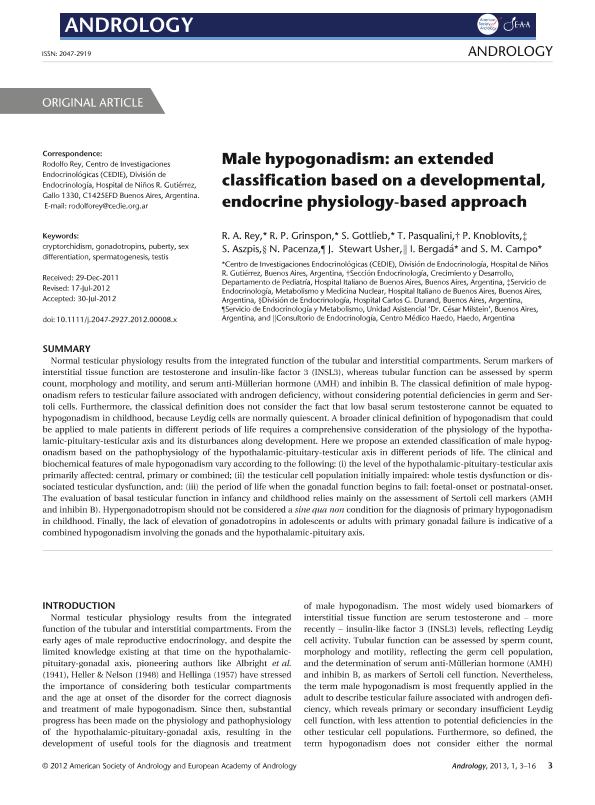Artículo
Male hypogonadism: an extended classification based on a developmental, endocrine physiology-based approach
Rey, Rodolfo Alberto ; Grinspon, Romina
; Grinspon, Romina ; Gottlieb, Silvia Elisa
; Gottlieb, Silvia Elisa ; Pascualini, T.; Knoblovits, P.; Aszpis, S.; Pacenza, N.; Stewart Usher, J.; Bergadá, Ignacio; Campo, Stella Maris
; Pascualini, T.; Knoblovits, P.; Aszpis, S.; Pacenza, N.; Stewart Usher, J.; Bergadá, Ignacio; Campo, Stella Maris
 ; Grinspon, Romina
; Grinspon, Romina ; Gottlieb, Silvia Elisa
; Gottlieb, Silvia Elisa ; Pascualini, T.; Knoblovits, P.; Aszpis, S.; Pacenza, N.; Stewart Usher, J.; Bergadá, Ignacio; Campo, Stella Maris
; Pascualini, T.; Knoblovits, P.; Aszpis, S.; Pacenza, N.; Stewart Usher, J.; Bergadá, Ignacio; Campo, Stella Maris
Fecha de publicación:
01/2013
Editorial:
Wiley
Revista:
Andrology
ISSN:
2047-2927
Idioma:
Inglés
Tipo de recurso:
Artículo publicado
Clasificación temática:
Resumen
Normal testicular physiology results from the integrated function of the tubular and interstitial compartments. Serum markers of interstitial tissue function are testosterone and insulin-like factor 3 (INSL3), whereas tubular function can be assessed by sperm count, morphology and motility, and serum anti-Mu¨llerian hormone (AMH) and inhibin B. The classical definition of male hypogonadism refers to testicular failure associated with androgen deficiency, without considering potential deficiencies in germ and Sertoli cells. Furthermore, the classical definition does not consider the fact that low basal serum testosterone cannot be equated to hypogonadism in childhood, because Leydig cells are normally quiescent. A broader clinical definition of hypogonadism that could be applied to male patients in different periods of life requires a comprehensive consideration of the physiology of the hypothalamic- pituitary-testicular axis and its disturbances along development. Here we propose an extended classification of male hypogonadism based on the pathophysiology of the hypothalamic-pituitary-testicular axis in different periods of life. The clinical and biochemical features of male hypogonadism vary according to the following: (i) the level of the hypothalamic-pituitary-testicular axis primarily affected: central, primary or combined; (ii) the testicular cell population initially impaired: whole testis dysfunction or dissociated testicular dysfunction, and: (iii) the period of life when the gonadal function begins to fail: foetal-onset or postnatal-onset. The evaluation of basal testicular function in infancy and childhood relies mainly on the assessment of Sertoli cell markers (AMH and inhibin B). Hypergonadotropism should not be considered a sine qua non condition for the diagnosis of primary hypogonadism in childhood. Finally, the lack of elevation of gonadotropins in adolescents or adults with primary gonadal failure is indicative of a combined hypogonadism involving the gonads and the hypothalamic-pituitary axis.
Palabras clave:
Cryptorchidism
,
Gonadotropins
,
Puberty
,
Sex Differentiation
,
Spermatogenesis
,
Testis
Archivos asociados
Licencia
Identificadores
Colecciones
Articulos(CEDIE)
Articulos de CENTRO DE INVESTIGACIONES ENDOCRINOLOGICAS "DR. CESAR BERGADA"
Articulos de CENTRO DE INVESTIGACIONES ENDOCRINOLOGICAS "DR. CESAR BERGADA"
Citación
Rey, Rodolfo Alberto; Grinspon, Romina; Gottlieb, Silvia Elisa; Pascualini, T.; Knoblovits, P.; et al.; Male hypogonadism: an extended classification based on a developmental, endocrine physiology-based approach; Wiley; Andrology; 1; 1; 1-2013; 3-16
Compartir
Altmétricas



